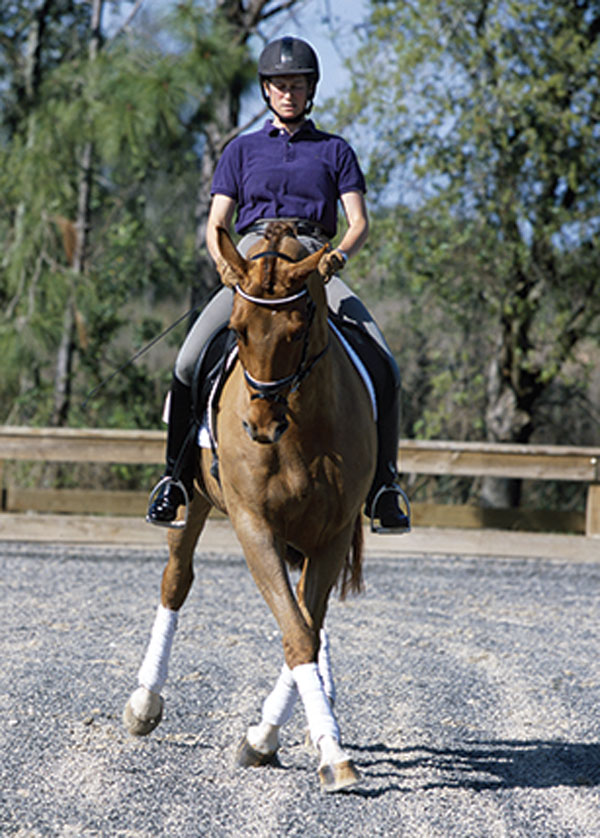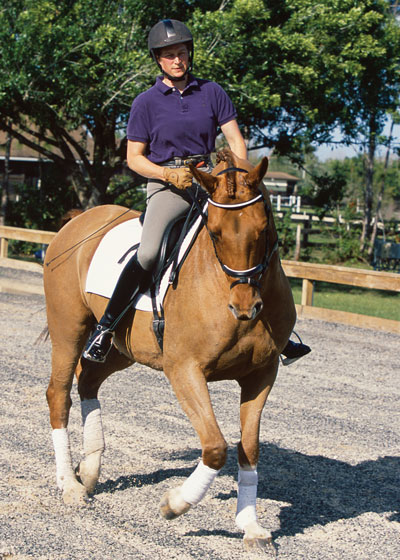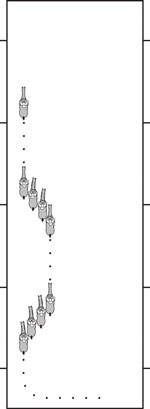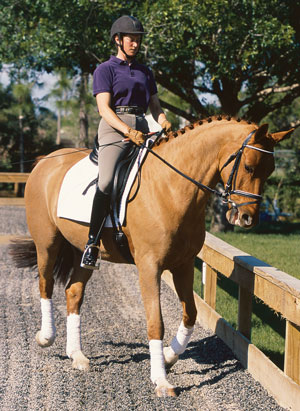
The leg-yield is the building block of most lateral work in dressage. In a leg-yield, the horse travels forward and sideways, moving away from one of the rider’s legs while remaining straight through his body. There is a tiny bit of flexion in the horse’s poll away from the direction of movement.

“Leg-yield teaches the horse two things,” says instructor and trainer Angelia Bean, a U.S. Dressage Federation bronze, silver, and gold medalist who operates Straight Forward Dressage in Glenmoore, Pa. “It teaches the horse to follow the rider’s weight in a sideways way, and to step with his inside hind leg diagonally underneath himself in a forward way.”
Getting Started
Here’s how Bean introduces the leg-yield concept. Start in the walk along
the long side of the arena, a few meters away from the rail. Shift your
weight slightly to the outside (the side nearest the rail). Most horses will
naturally take a step or two of leg-yield toward the rail because they want
to be balanced under the rider’s weight.
Remember the turn on the forehand (see “Turn on the Forehand” in Horse Illustrated July 2019), which taught your horse to move his haunches away from your inside leg?

Now, you’re going to incorporate that inside-leg aid so that you’re asking him to step both sideways and forward while your outside aids say, “Don’t go sideways too fast; keep traveling forward and maintain your alignment.”
But as Bean explains, when some riders are learning to use a unilateral (single) leg aid, they lean toward that side, which contradicts the leg aid. That’s why she usually starts by teaching the weight aid and adds the leg aid later.
Eventually the sequence becomes “bump with the inside leg; shift your weight; bump with the inside leg; shift your weight,” she says. After horse and rider get the hang of traveling forward and sideways, then the sequence becomes bump with leg; weight shift; and slight “containing” squeeze with the outside rein to prevent the horse’s shoulders from falling sideways and losing the alignment of his body, she says.
Used correctly, the outside rein actually encourages the crossing of the horse’s hind legs because it limits how much the inside hind leg can step straight forward, she explains.
Try It at the Trot
After you and your horse feel confident leg-yielding a few steps in the walk in both directions, try it in the trot, either rising or sitting. You may actually find the movement easier in the trot because you’ll naturally be inclined to use your inside leg during the moment of suspension in the gait, says Bean.

Use the arena letter markers to help you ride an accurate diagonal line. In First Level Test 2, the movement is ridden from the center line to the rail—a width of only 10 meters—over 36 meters, so the angle is quite shallow.
There’s no “wow” feeling to a correctly ridden leg-yield, says Bean. If your horse glides smoothly along the desired line while maintaining the alignment and the trot tempo, you’re doing it right.
If you find yourself drawing your inside leg back because he isn’t moving away from it, or you’re pulling on the inside rein to stop that falling-sideways feeling, you either need to reinforce the obedience to your inside leg or correct the alignment. Let the geometry help you to assess the correctness of your riding and training.
This article on how to leg yield originally appeared in the July 2019 issue of Horse Illustrated magazine. Click here to subscribe!






